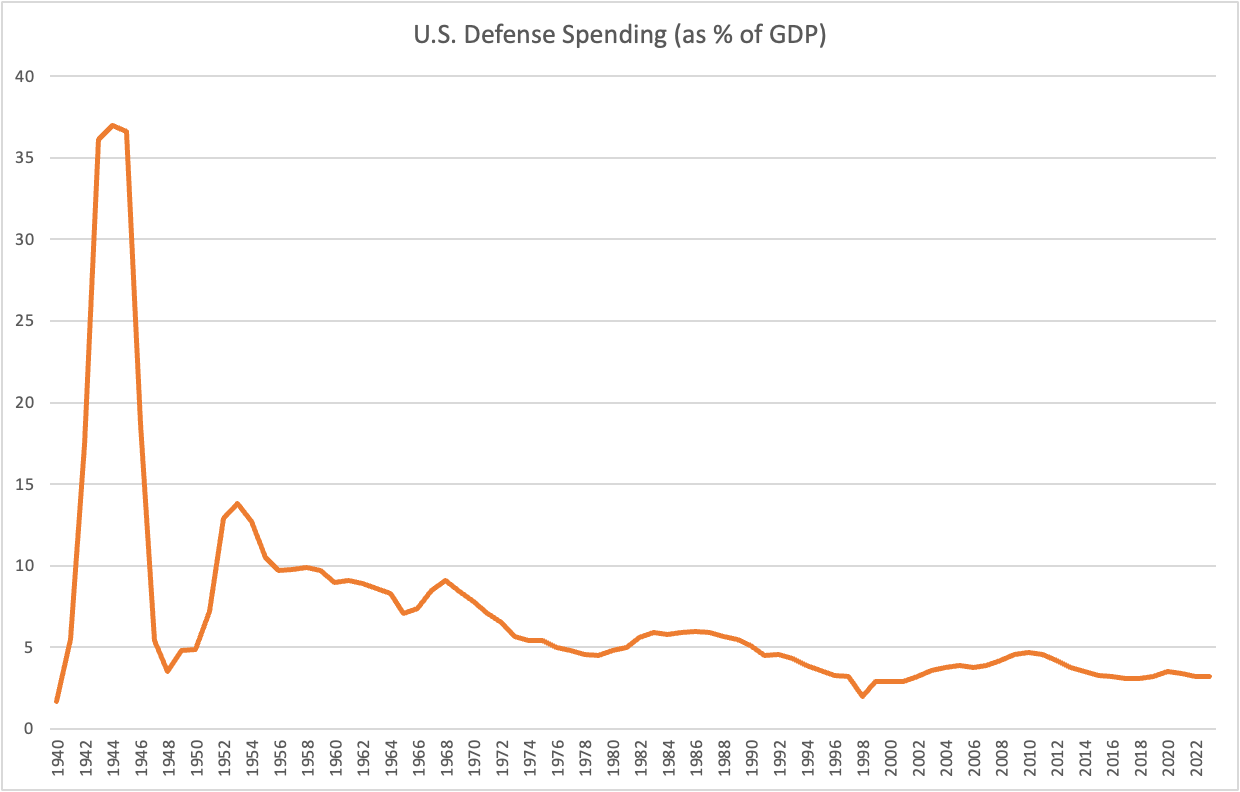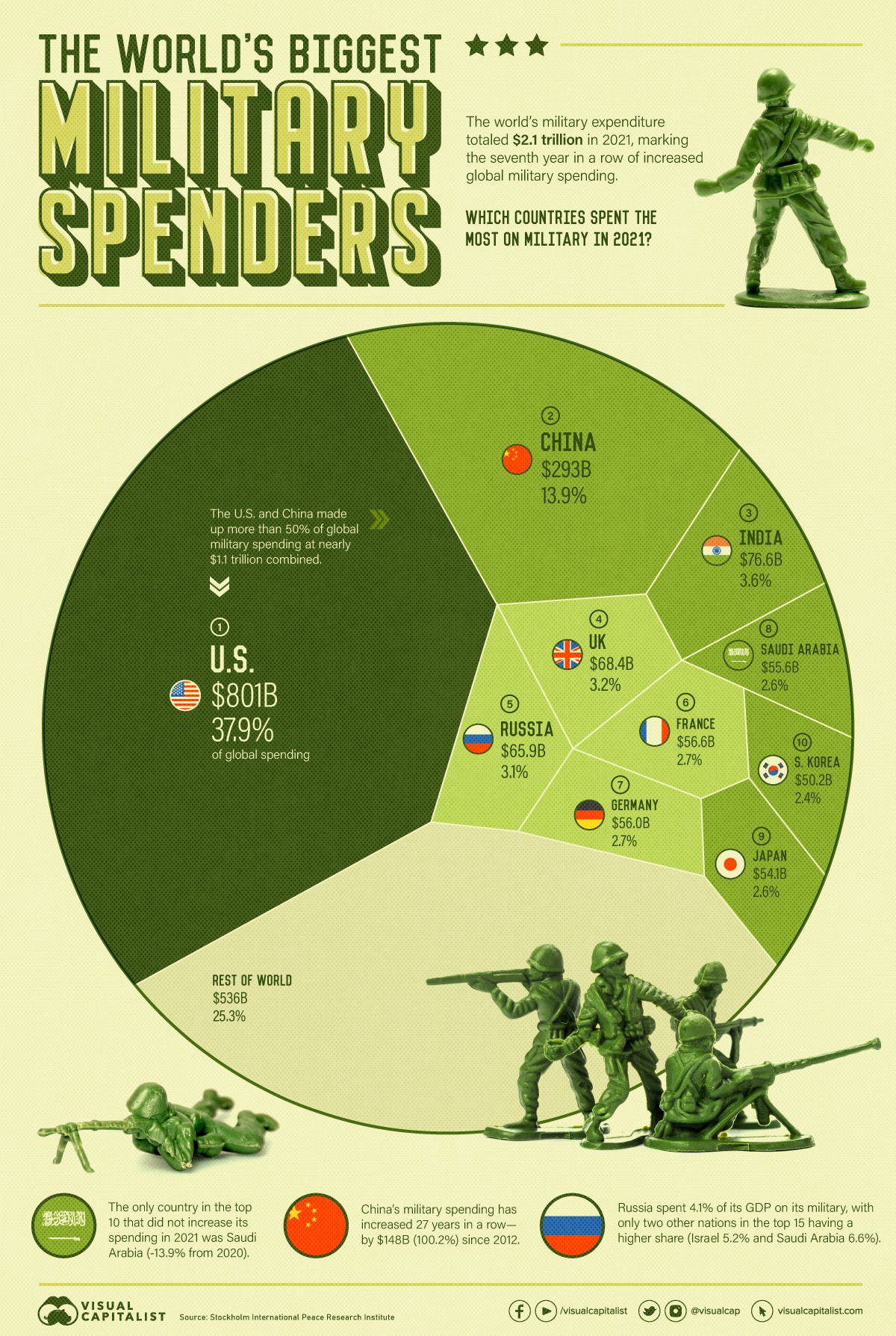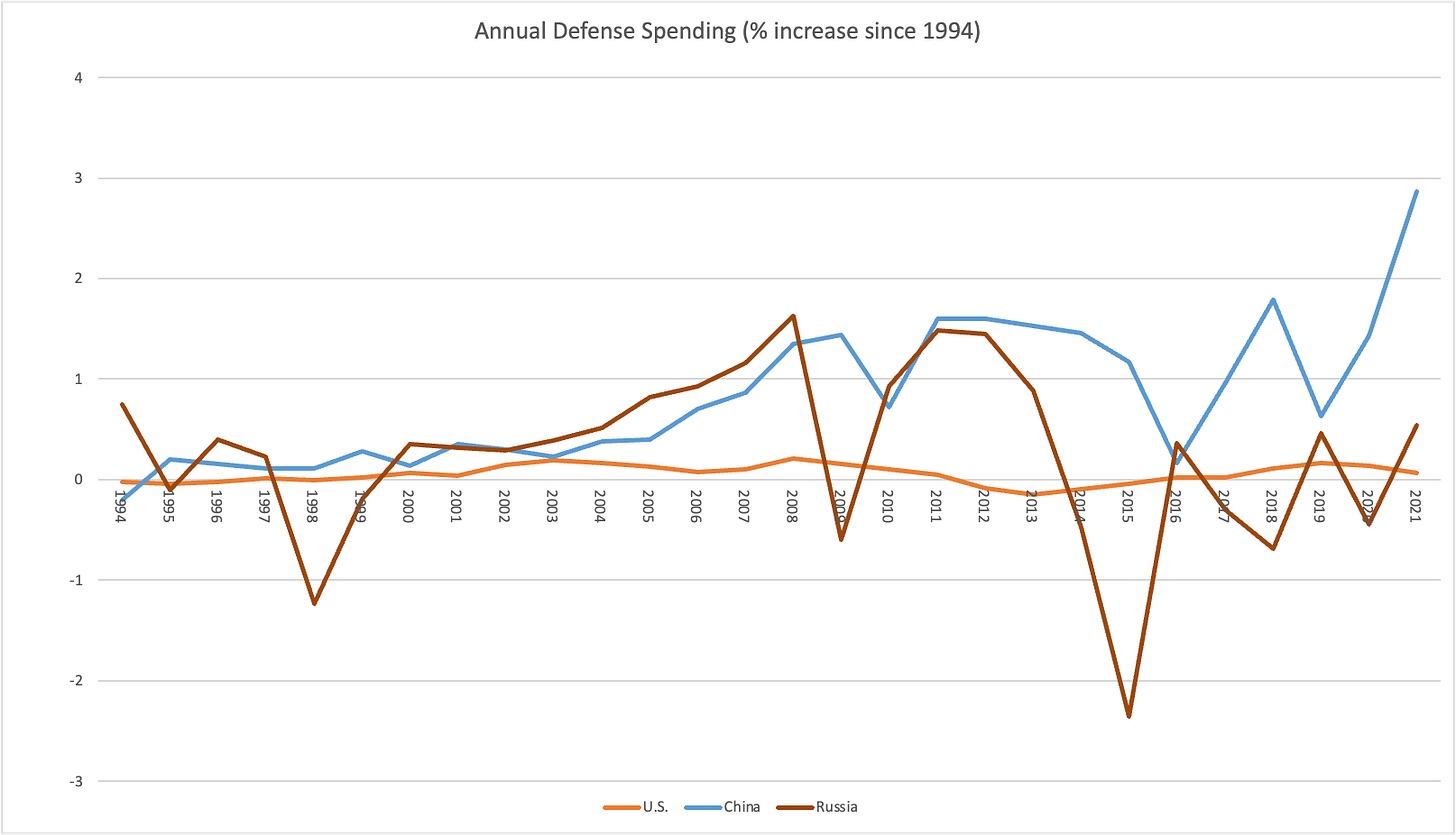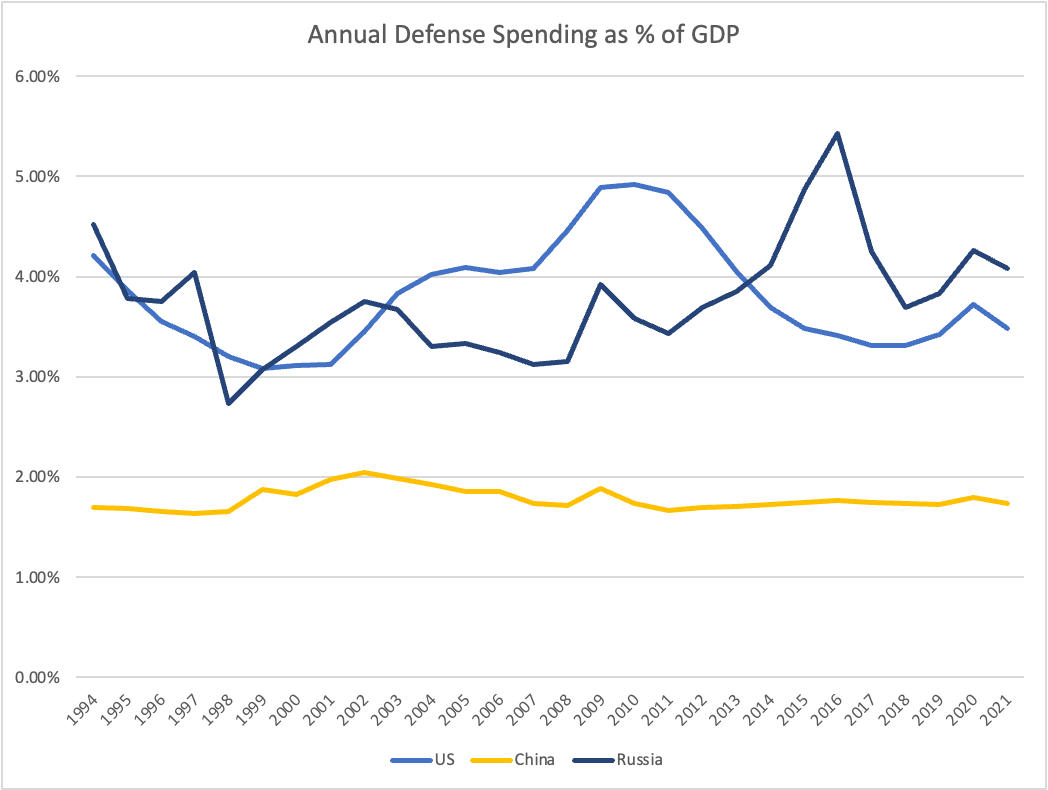America’s record defense budget for 2023 swamps its enemies’ and girds for World War III, but is still losing to the economy.
(Originally published Dec. 19 in “What in the World“) The New York Times has just broken the news that U.S. military spending is rising, not just to support the war in Ukraine, where President Volodymyr Zelensky warns Russia may be about to launch a winter offensive, but to fight the new Cold War against China and Russia and whatever other bogeymen imperil the American Way.
After weeks of wrangling over legislation for U.S. President Joe Biden’s proposed military budget for 2023, lawmakers approved the bill only after heaping more into it than either Biden or the Pentagon requested. The Times has sniffed out a trend here: U.S. military outlays have been climbing at an inflation-adjusted rate of 4.3% for the past two years after rising just 1% from 2015 to 2021. U.S. military spending in 2023 will be the highest it has been in real terms since the peak of the twin wars in Afghanistan and Iraq in 2008 and 2011, and the second-highest annual budget (again, in real, inflation-adjusted terms) since World War II. And the U.S. isn’t even technically at war.
A lot of next year’s increase is designed to refill arsenals depleted by the war in Ukraine, as we have previously detailed, including a 55% increase in funding for the Army to buy missiles and a 47% increase for the Navy to build new ships, $950 million for Lockheed Martin and $2 billion for Raytheon. Since Biden took office, the U.S. has shoveled $20 billion in military aid and materiel to Ukraine, $19.3 billion of it since Russia’s invasion in February. A full Pentagon account is below.
But it’s also an investment in building up America’s defenses beyond Ukraine, to turn Taiwan into a bristling porcupine against possible attack by China, and to expand America’s capacity for producing more weapons faster. That means allowing the Pentagon to make longer-term, multi-year purchase deals with weapons makers so that they are confident they will profit if they make the big outlays needed to build new factories.
Even at its new record high, however, U.S. government spending has been falling as a proportion of the U.S. economy. From 1.7% before the Japanese attacked Pearl Harbor, spending on national defense soared to 37% of GDP during World War II and to almost 14% during the Korean War, but has been steadily dwindling since. There was a sharp uptick during the escalation of the Vietnam War during the Johnson Administration, a gentle increase during the Reagan Administration and another buildup after 9/11 as the U.S. prosecuted wars in Iraq and Afghanistan.

On one hand, this suggests the U.S. is getting more efficient at maintaining its global military dominance—it is becoming less expensive for the U.S. to maintain Pax Americana. On the other, it suggests that public spending on defense isn’t keeping up as a tool of domestic fiscal policy, given that defense spending like any other form of government spending contributes directly to GDP. Defense spending has also been declining as a percentage of the Federal budget, even though next year’s defense budget will exceed the combined budgets of the 10 largest U.S. Federal agencies.
Yet no other nation spends as much as the U.S. on its military. Japan just unveiled plans to double its military budget, to 2% of its GDP, as it frets over threats from North Korea and China. But even that will only reach $80 billion by 2027. China is second to the U.S., but even it only spent $293 billion in 2021. And that amounts to only 1.7% of its GDP.
European nations, from Sweden and Denmark to Germany and Spain, have been boosting their own defense spending in the face of Russia’s threat, too. But Europe still spends less than 2% of its combined GDP on defense. Members of the North Atlantic Treaty Organization are committed to spending at least 2% of their GDP on defense. But only 10 of NATO’s 30 members, including the U.S., meet that target. And aside from Greece and the United Kingdom, seven of them are former Soviet satellites that share the zeal of the converted and proximity to Russia’s border: Croatia, Estonia, Latvia, Lithuania, Romania, Slovakia, and Poland.
Lithuania just signed a $495 million deal to buy Lockheed Martin’s M142 High Mobility Artillery Rocket Systems, or Himars, together with Army Tactical Missile Systems, or Atacms. You may recall that Himars are the precision rocket launchers that Ukraine has used to devastating effect on Russian logistics and personnel. But Atacms are the longer-range missiles that Washington has so far refused to give to Ukraine for fear they’ll launch them against targets inside Russia, even going so far as to hobble Ukraine’s Himars so they can’t launch Atacms acquired from somewhere else.
The list of nations that devote as much or more of their economy to defense than the U.S. is largely confined to North Africa, the Middle East and Central Asia, with one notable exception: Russia. In 2020, Russia spent the equivalent of 4.3% of its GDP on defense, an amount that still doesn’t amount to even 10% of the U.S. defense budget.

And while it may seem alarming that China’s nominal outlays on defense have soared in recent years…

They’ve stayed largely in line with the growth of China’s faster growing economy, and thus steady as a proportion of GDP…

Herewith the Pentagon’s tally of what the U.S. has sent Ukraine so far:
· Over 1,600 Stinger anti-aircraft systems;
· Over 8,500 Javelin anti-armor systems;
· Over 46,000 other anti-armor systems and munitions;
· Over 700 Switchblade Tactical Unmanned Aerial Systems;
· 142 155mm Howitzers and up to 1,004,000 155mm artillery rounds;
· 4,200 precision-guided 155mm artillery rounds;
· 9,000 155mm rounds of Remote Anti-Armor Mine (RAAM) Systems;
· 36 105mm Howitzers and 180,000 105mm artillery rounds;
· 276 Tactical Vehicles to tow weapons;
· 22 Tactical Vehicles to recover equipment;
· 38 High Mobility Artillery Rocket Systems and ammunition;
· 20 120mm mortar systems and 135,000 120mm mortar rounds;
· 1,500 Tube-Launched, Optically-Tracked, Wire-Guided (TOW) missiles;
· Four Command Post vehicles;
· Eight National Advanced Surface-to-Air Missile Systems (NASAMS) and munitions;
· Missiles for HAWK air defense systems;
· Four Avenger air defense systems;
· High-speed Anti-radiation missiles (HARMs);
· 20 Mi-17 helicopters;
· 45 T-72B tanks;
· Over 1,000 High Mobility Multipurpose Wheeled Vehicles (HMMWVs);
· Over 100 light tactical vehicles;
· 44 trucks and 88 trailers to transport heavy equipment;
· 200 M113 Armored Personnel Carriers;
· 250 M1117 Armored Security Vehicles
· 440 MaxxPro Mine Resistant Ambush Protected Vehicles;
· Mine clearing equipment and systems;
· Over 11,000 grenade launchers and small arms;
· Over 104,000,000 rounds of small arms ammunition;
· Over 75,000 sets of body armor and helmets;
· Approximately 1,800 Phoenix Ghost Tactical Unmanned Aerial Systems;
· Laser-guided rocket systems;
· Puma Unmanned Aerial Systems;
· 15 Scan Eagle Unmanned Aerial Systems;
· Two radars for Unmanned Aerial Systems;
· Unmanned Coastal Defense Vessels
· Over 50 counter-artillery radars;
· Four counter-mortar radars;
· 20 multi-mission radars;
· Counter-Unmanned Aerial Systems and equipment;
· Counter air defense capability;
· Ten air surveillance radars;
· Two harpoon coastal defense systems;
· 58 coastal and riverine patrol boats;
· M18A1 Claymore anti-personnel munitions;
· C-4 explosives, demolition munitions, and demolition equipment for obstacle clearing;
· Obstacle emplacement equipment;
· Tactical secure communications systems;
· Four satellite communications antennas;
· Thousands of night vision devices, surveillance systems, thermal imagery systems,
optics, and laser rangefinders;
· Commercial satellite imagery services;
· Explosive ordnance disposal equipment and protective gear;
· Chemical, Biological, Radiological, Nuclear protective equipment;
· 100 armored medical treatment vehicles;
· Over 350 generators;
· Medical supplies to include first aid kits, bandages, monitors, and other equipment;
· Electronic jamming equipment;
· Field equipment, cold weather gear, and spare parts;
· Funding for training, maintenance, and sustainment